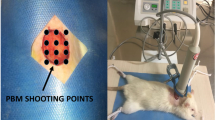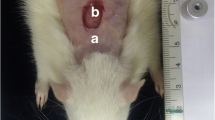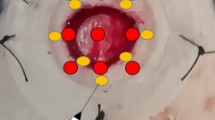Abstract
The combined and individual influences of photobiomodulation therapy (PBMT) and arginine on wound strength, stereological parameters, and gene expressions of some related growth factors in ischemic and delayed healing wounds in rats were analyzed. We divided 108 rats into six groups: control, lower energy density (LOW)-PBMT, 2% arginine ointment (Arg 2%), LOW-PBMT + Arg 2%, high energy density (HIGH)-PBMT, and HIGH-PBMT + Arg 2%. First, we generated an ischemic and delayed healing wound model in each rat. We examined wound strength, stereological parameters, and gene expressions of basic fibroblast growth factor (bFGF), vascular endothelial growth factor A (VEGF-A), and stromal cell-derived factor 1 (SDF-1) by quantitative real-time polymerase chain reaction (qRT-PCR). PBMT alone and PBMT + Arg 2% considerably increased wound strength compared to the control and Arg 2% groups during the inflammatory and proliferative steps of wound healing (p < 0.05). In these steps, PBMT alone significantly induced an anti-inflammatory effect and increased fibroblast counts; Arg 2% alone induced an inflammatory response (p < 0.05). Concurrently, PBMT and PBMT + Arg 2% significantly increased keratinocyte counts and volume of the new dermis (p < 0.05). At the remodeling step, the Arg 2% groups had significantly better wound strength than the other groups (p < 0.05). In this step, PBMT and PBMT + Arg 2% significantly decreased inflammation, and increased fibroblast counts, vascular length, and the volume of new epidermis and dermis compared to the control and Arg 2% groups (p < 0.05). In all cases of gene analysis, there were statistically better results in the PBMT and PBMT + Arg 2% groups compared with the Arg 2% and control groups (p < 0.05). The anti-inflammatory and repairing effects of PBMT on an ischemic and delayed healing wound model in rats were shown by significant improvements in wound strength, stereological parameters, and gene expressions of bFGF, VEGF-A, and SDF-1α.






Similar content being viewed by others
Data availability
Supplementary files provide some of the statistical analyses for the stereological and gene expression assessments.
References
Sen C, Roy S, Gordillo G (2017) Wound healing (Neligan Plastic Surgery: Volume One). Elsevier, Amsterdam
Järbrink K, Ni G, Sönnergren H, Schmidtchen A, Pang C, Bajpai R, Car J (2017) The humanistic and economic burden of chronic wounds: a protocol for a systematic review. Syst Rev 6(1):15
Sen CK (2019) Human wounds and its burden: an updated compendium of estimates. Mary Ann Liebert, Inc., Publishers, 140 Huguenot Street, 3rd Floor New
Elgharably H, Ganesh K, Dickerson J, Khanna S, Abas M, Ghatak PD, Dixit S, Bergdall V, Roy S, Sen CK (2014) A modified collagen gel dressing promotes angiogenesis in a preclinical swine model of chronic ischemic wounds. Wound Repair Regen 22(6):720–729
Sen CK, Gordillo GM, Roy S, Kirsner R, Lambert L, Hunt TK, Gottrup F, Gurtner GC, Longaker MT (2009) Human skin wounds: a major and snowballing threat to public health and the economy. Wound Repair Regen 17(6):763–771
Kamler M, Lehr H-A, Barker J, Saetzler R, Galla T, Messmer K (1993) Impact of ischemia on tissue oxygenation and wound healing: intravital microscopic studies on the hairless mouse ear model. Eur Surg Res 25(1):30–37
Quirinia A (2000) Ischemic wound healing and possible treatments. Drugs Today (Barc) 36(1):41–53
Roy S, Biswas S, Khanna S, Gordillo G, Bergdall V, Green J, Marsh CB, Gould LJ, Sen CK (2009) Characterization of a preclinical model of chronic ischemic wound. Physiol Genomics 37(3):211–224
Patil P, Martin JR, Sarett SM, Pollins AC, Cardwell NL, Davidson JM, Guelcher SA, Nanney LB, Duvall CL (2017) Porcine ischemic wound-healing model for preclinical testing of degradable biomaterials. Tissue Eng Part C Methods 23(11):754–762
de Freitas LF, Hamblin MR (2016) Proposed mechanisms of photobiomodulation or low-level light therapy. IEEE J Select Top Quantum Electron 22(3):348–364
Hamushan M, Cai W, Lou T, Cheng P, Zhang Y, Tan M, Chai Y, Zhang F, Lineaweaver WC, Han P (2020) Postconditioning with red-blue light therapy improves survival of random skin flaps in a rat model. Ann Plast Surg
Ma J-X, Yang Q-M, Xia Y-C, Zhang W-G, Nie F-F (2018) Effect of 810 nm near-infrared laser on revascularization of ischemic flaps in rats. Photomed Laser Surg 36(6):290–297. https://doi.org/10.1089/pho.2017.4360
Martignago CCS, Tim CR, Assis L, Andrade ALM, Brassolati P, Bossini PS, Leiebano RE, Parizotto NA (2019) Preemptive treatment with photobiomodulation therapy in skin flap viability. J Photochem Photobiol B Biol 201:111634. https://doi.org/10.1016/j.jphotobiol.2019.111634
das Neves LMS, Leite GPMF, Marcolino AM, Pinfildi CE, Garcia SB, de Araújo JE, de Oliveira Guirro EC (2017) Laser photobiomodulation (830 and 660 nm) in mast cells, VEGF, FGF, and CD34 of the musculocutaneous flap in rats submitted to nicotine. Lasers Med Sci 32(2):335–341
Cury V, Moretti AIS, Assis L, Bossini P, de Souza CJ, Neto CB, Fangel R, De Souza HP, Hamblin MR, Parizotto NA (2013) Low level laser therapy increases angiogenesis in a model of ischemic skin flap in rats mediated by VEGF, HIF-1α and MMP-2. J Photochem Photobiol B Biol 125:164–170
Hatori K, Camargos G, Chatterjee M, Faot F, Sasaki K, Duyck J, Vandamme K (2015) Single and combined effect of high-frequency loading and bisphosphonate treatment on the bone micro-architecture of ovariectomized rats. Osteoporos Int 26(1):303–313
Stechmiller JK, Childress B, Cowan L (2005) Arginine supplementation and wound healing. Nutr Clin Pract 20(1):52–61
Shi HP, Efron DT, Most D, Tantry US, Barbul A (2000) Supplemental dietary arginine enhances wound healing in normal but not inducible nitric oxide synthase knockout mice. Surgery 128(2):374–378
Shi HP, Most D, Efron DT, Witte MB, Barbul A (2003) Supplemental L-arginine enhances wound healing in diabetic rats. Wound Repair Regen 11(3):198–203
Alexander JW, Supp DM (2014) Role of arginine and omega-3 fatty acids in wound healing and infection. Adv Wound Care 3(11):682–690
Mostafavinia A, Bidram M, Avili AG, Mahmanzar M, Karimifard SA, Sajadi E, Amini A, Jahromy MH, Ghoreishi SK, Chien S (2019) An improvement in acute wound healing in rats by the synergistic effect of photobiomodulation and arginine. Lab Anim Res 35(1):1–11
Sharifian Z, Bayat M, Alidoust M, Farahani RM, Bayat M, Rezaie F, Bayat H (2014) Histological and gene expression analysis of the effects of pulsed low-level laser therapy on wound healing of streptozotocin-induced diabetic rats. Lasers Med Sci 29(3):1227–1235
Park JW, Hwang SR, Yoon I-S (2017) Advanced growth factor delivery systems in wound management and skin regeneration. Molecules 22(8):1259
Moradi A, Zare F, Mostafavinia A, Safaju S, Shahbazi A, Habibi M, Abdollahifar MA, Hashemi SM, Amini A, Ghoreishi SK, Chien S, Hamblin MR, Kouhkheil R, Bayat M (2020) Photobiomodulation plus Adipose-derived Stem Cells Improve Healing of Ischemic Infected Wounds in Type 2 Diabetic Rats. Sci Rep. 27;10(1):1206. https://doi.org/10.1038/s41598-020-58099-z.
Dadpay M, Sharifian Z, Bayat M, Bayat M, Dabbagh A (2012) Effects of pulsed infra-red low level-laser irradiation on open skin wound healing of healthy and streptozotocin-induced diabetic rats by biomechanical evaluation. J Photochem Photobiol B 111:1–8. https://doi.org/10.1016/j.jphotobiol.2012.03.001
Hamblin MR (2017) Mechanisms and applications of the anti-inflammatory effects of photobiomodulation. AIMS Biophys 4(3):337–361. https://doi.org/10.3934/biophy.2017.3.337
Hicks-Roof K (2018) The use of an arginine-enriched oral nutrition supplement to enhance wound healing from a cesarean section. Case Rep Clin Nutr 1(1-3):1–7
Schneider KL, Yahia N. Effectiveness of Arginine Supplementation on Wound Healing in Older Adults in Acute and Chronic Settings: A Systematic Review. Adv Skin Wound Care. 2019 Oct;32(10):457–462. https://doi.org/10.1097/01.ASW.0000579700.20404.56
Silva JJ, Pompeu DG, Ximenes NC, Duarte AS, Gramosa NV, Carvalho Kde M, Brito GA, Guimarães SB (2015) Effects of kaurenoic acid and arginine on random skin flap oxidative stress, inflammation, and cytokines in rats. Aesthet Plast Surg 39(6):971–977. https://doi.org/10.1007/s00266-015-0559-8
Gündoğdu RH, Temel H, Bozkırlı BO, Ersoy E, Yazgan A, Yıldırım Z. Mixture of Arginine, Glutamine, and β-hydroxy-β-methyl Butyrate Enhances the Healing of Ischemic Wounds in Rats. JPEN J Parenter Enteral Nutr. 2017 Aug;41(6):1045–1050. https://doi.org/10.1177/0148607115625221
Carroll JD, Milward MR, Cooper PR, Hadis M, Palin WM (2014) Developments in low level light therapy (LLLT) for dentistry. Dent Mater 30(5):465–475. https://doi.org/10.1016/j.dental.2014.02.006
Rizzi M, Migliario M, Tonello S, Rocchetti V, Renò F (2018) Photobiomodulation induces in vitro re-epithelialization via nitric oxide production. Lasers Med Sci 33(5):1003–1008. https://doi.org/10.1007/s10103-018-2443-7
Hamblin MR, de Sousa MVP, Arany PR, Carroll JD, Patthoff D (2015) Low level laser (light) therapy and photobiomodulation: the path forward. In: Mechanisms for low-light therapy X. International Society for Optics and Photonics, p 930902
Yadav A, Gupta A (2017) Noninvasive red and near-infrared wavelength-induced photobiomodulation: promoting impaired cutaneous wound healing. Photodermatol Photoimmunol Photomed 33(1):4–13
Funding
Research reported in this publication was in part supported by Elite Researcher Grant Committee under award number [971122] from the National Institutes for Medical Research Development (NIMAD), Tehran, Iran, in part by Dr Atarodsadat Mostafavinia and Dr Mohammad Bayat. Dr. Sufan Chien was supported in part by NIH grant DK105692.
Author information
Authors and Affiliations
Corresponding authors
Ethics declarations
Ethics approval and consent to participate
The IRB of National Institute for Medical Research Development (NIMAD), Tehran, Iran (file no: IR.NIMAD.REC.1397.256) approved all this study and its experiments.
Consent for publication
Not applicable.
Conflict of interest
The authors declare no competing interests.
Additional information
Publisher’s note
Springer Nature remains neutral with regard to jurisdictional claims in published maps and institutional affiliations.
Supplementary Information
ESM 1
(DOCX 81 kb)
Rights and permissions
About this article
Cite this article
Mostafavinia, A., Amini, A., Sajadi, E. et al. Photobiomodulation therapy was more effective than photobiomodulation plus arginine on accelerating wound healing in an animal model of delayed healing wound. Lasers Med Sci 37, 403–415 (2022). https://doi.org/10.1007/s10103-021-03271-8
Received:
Accepted:
Published:
Issue Date:
DOI: https://doi.org/10.1007/s10103-021-03271-8




